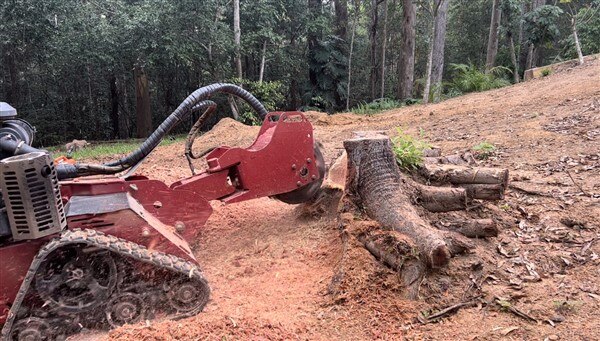STUMPWORKS QLD – PROMPT PROFESSIONAL SERVICE
STUMPWORKS QLD – PROMPT PROFESSIONAL SERVICE
Have you ever found yourself admiring the stunning landscape of a park or a well-maintained garden, only for your gaze to land on an unsightly tree stump that mars the view? Perhaps you’ve wondered – just how long would it take to grind that stump down and reclaim the beauty of the landscape? Well, you’ve landed at the right place to unearth the answer!
In this blog, we’ll journey together into the world of stump grinding: how long it takes, the factors involved, and how you can get a realistic estimate before you dive into the task.

Before we guide you about how you can estimate the time, it’s essential to understand the variables involved. Stump grinding isn’t a one-size-fits-all operation. Several factors come into play, each contributing to the overall duration.
When it comes to stump grinding, size does matter. The larger the stump, the more time you will need to grind it down completely. The stump’s diameter and height play significant roles in determining the duration of the job.
The root structure complicates the matter further. Stumps with extensive, deep roots consume more time as they require thorough grinding to prevent regrowth.
Estimations of time based on size and complexity are not purely mathematical. Experience, paired with understanding the characteristics of different tree species, helps in providing a more accurate estimate. Remember, stump grinding is part science, part art.
The choice of equipment for a job, combined with the skill of an operator, can make a significant difference in the time it takes to grind a stump. Depending on their type and quality, some machines can enhance efficiency, allowing for faster and more effective grinding.
Just as a well-tuned instrument is vital for a brilliant performance, the condition and quality of stump grinding equipment play a crucial role. High-grade machinery not only increases the speed of the task but also ensures safety and reduces the risk of damaging the surrounding landscape.
Yet, even the most advanced equipment would be propelled only so far without a skilled operator at its helm. Experience, understanding, and expertise of the operator truly shape the speed and the success of the grind. An experienced operator knows how to navigate complex root systems, how to adjust strategies according to various stump sizes and species, and how to manoeuvre equipment to its full potential.
The union of the right equipment and a skilled operator significantly influences the efficiency and speed of stump grinding. This combination promotes precision, safeguards the surrounding vegetation, and enables a level of productivity that leads to time-saving.
While stump size and equipment may be uppermost in mind, stump grinding is not just about the target tree stump itself. The location and immediate surroundings also contribute to the time taken for the task. Stump accessibility and its proximity to structures, obstacles, or utility lines introduces various challenges that impede speed and efficiency.
If a stump is situated in an easily accessible spot, the grinders can be manoeuvred into position with ease, accelerating the grinding process. However, if the stump is tucked away in a hard-to-reach corner or buried on a steep slope, additional preparation and care in operating the machinery might become necessary, thereby prolonging the task.
The proximity to other structures, obstacles like rocks or fences, or the presence of utility lines further complicates the situation. These factors require the operator to approach the stump cautiously, navigate the machinery more precisely, and thus, spend more time on the project. Additionally, ensuring the safety of the operator, as well as maintaining the integrity of utilities and protecting the nearby features, demands an extra layer of tact and skill.
In essence, the interplay of accessibility and surroundings impacts not only the manoeuvrability of the equipment but also the overall safety and efficacy of the stump grinding process. Meticulous planning and attention to these factors can minimise potential setbacks and help create a smoother, and faster, grinding experience.
The physical state of the ground around a tree stump is an often-underestimated factor in determining stump grinding duration. Soil moisture and composition play vital roles in affecting the ease and speed of the process, with varying levels of challenge posed by different ground conditions.
Like any natural environment, soil isn’t uniform. It ranges from dry and sandy to wet and clay-like. The level of moisture in the soil can significantly impact the ease of grinding. Dry, hard soil might require extra effort to break through and access the tree roots, thereby slowing down the process.
On the other hand, soft, waterlogged soil can be more pliable, making it easier to manoeuvre the equipment and grind the stump. However, very wet soil conditions might lead to issues with traction, causing machinery to get stuck or operate inefficiently.
The composition of the surrounding soil has a direct bearing on the stump grinding process. Rocky soil can be especially challenging, as it can pose potential hazards to the equipment and operator. Boulders and stones hidden below the surface may damage the grinding wheel or cause unforeseen complications, requiring more time and effort by the operator to work around such obstacles.
In the face of challenging soil conditions, certain adjustments need to be made to ensure a safe and efficient grinding process. Skilled operators are able to make these adaptations on-the-fly, adjusting their approach and techniques depending on the prevailing ground conditions. For instance, in rocky soil, the operator may opt for slower grinder rotations or employ alternative methods to work around obstacles. Similarly, for waterlogged soils, operators may need to use specialised equipment or alter the angle of grinding to maintain a steady grip on the slippery ground.
The soil condition greatly affects the speed and ease of stump grinding. Being aware of and adapting to various challenges posed by different ground compositions are crucial for successfully executing the task while maximising both safety and efficiency.
Having understood the multitude of factors affecting the stump grinding process, it becomes essential to translate these into practical terms. In this section, we’ll delve into some average duration estimates for grinding stumps of varying sizes. We’ll provide a benchmark that, while not absolute, can act as a general guide in estimating the time required for your unique situation.
Small, manageable stumps can range from only a few inches in diameter to about one foot. These stumps, often left from young, small trees or shrubs, distinguish themselves by their relatively thin diameters and height.
Given that size, complexity, and soil conditions are ideal and the operator has a decent level of skill, grinding a small stump may take roughly 15 minutes to one hour. However, these timings are approximations and may vary in individual circumstances due to influences like stump species, root structure, and equipment efficiency. It reinforces the point that stump grinding is a series of nuances, each situation presenting unique demands that impact the overall duration.
Stumps considered medium-sized generally range from about 1 to 2 feet in diameter. They are often remnants of moderately mature trees and present a greater challenge than smaller stumps due to their more extensive root systems and more considerable bulk.
Given that conditions, including the stump’s root complexity, soil characteristics, and operator skills, are reasonably favourable, grinding a medium-sized stump typically may take anywhere from 45 minutes to 2 hours.
However, much like with smaller stumps, these time estimates can significantly vary depending on different elements such as tree species and the grinding equipment in use. At times, the surrounding environment or accessibility issues might introduce extra complexities, necessitating additional time. These illustrations are for guiding purposes and may not reflect the exact durations for specific situations.
Large or complex stumps, as the name suggests, refer to those with diameters exceeding 2 feet or those posing additional challenges due to complexity, location, or root system. These can be remnants of mature trees or trees with multiple trunks or copious root systems. These stumps often demand even more time and skill to remove due to their increased bulk and the complexities surrounding them.
When it comes to grinding large or complex stumps under favourable conditions such as clear access and cooperative soil characteristics, the time frame for stump removal can range from 2 hours to several hours or even a full day. However, it’s important to recognize that these are general estimates and can vary substantially based on several factors, such as the tree species, equipment efficiency, and operator skill.
In more difficult cases, where access is restricted or the stump is dangerously close to utility lines, structures, or obstacles, the process might require additional time for extra care, planning, and adjustments, extending the overall grinding process.
While estimating time frames for large or complex stump removal, it is highly recommended to exercise caution and account for the myriad elements that could impact the process to ensure accurate planning. Due to these reasons, seeking help from an experienced professional is particularly advisable when tackling larger stumps or tackling ones in challenging locations.

Negotiating stump removal can be tricky, but not with Stumpworks QLD by your side. We possess the necessary skills, experience, and equipment to tackle stumps of any size or complexity.
We understand the importance of time efficiency and offer only the highest quality service. From start to the spotless finish, we ensure customer satisfaction.
So, why wait? Contact us today and bid farewell to those bothersome stumps.

Stumpworks QLD is a family-owned and operated business, a team made up of skilled professionals who enjoy their work and are dedicated to getting excellent results for our customers. Since 2022, we are dedicated in offering exceptional stump grinding and removal services in Sunshine Coast, Queensland, Australia.
2 Irving Pl, Sippy Downs QLD 4556, Australia